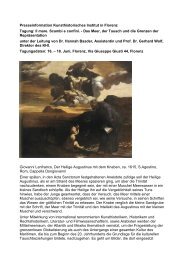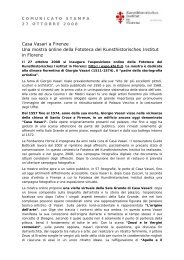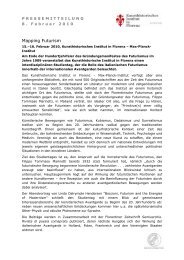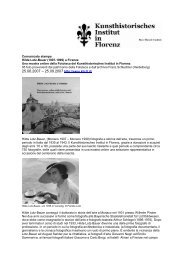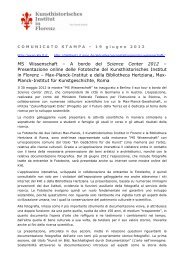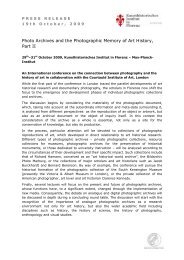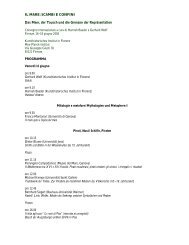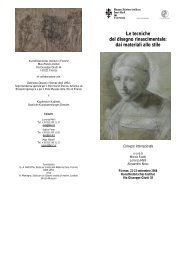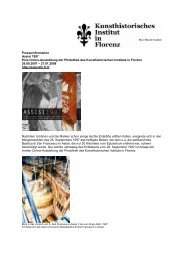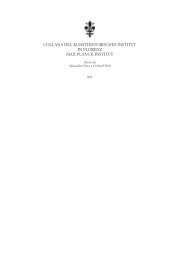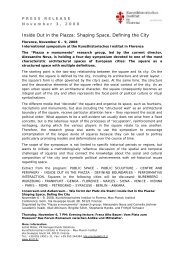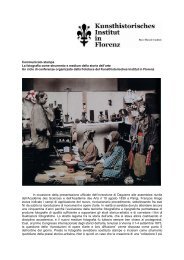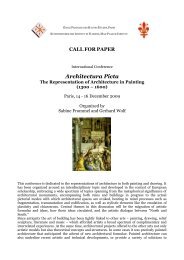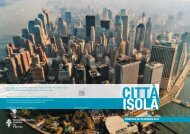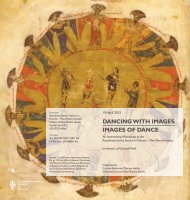Statusbericht - Homepage - Kunsthistorisches Institut in Florenz
Statusbericht - Homepage - Kunsthistorisches Institut in Florenz
Statusbericht - Homepage - Kunsthistorisches Institut in Florenz
Sie wollen auch ein ePaper? Erhöhen Sie die Reichweite Ihrer Titel.
YUMPU macht aus Druck-PDFs automatisch weboptimierte ePaper, die Google liebt.
Forschungsbericht<br />
27. – 29. Mai 2004<br />
Convegno <strong>in</strong> der Sala Quadrivium, Genua<br />
Intorno al Sacro Volto. Genova, Bisanzio e il Mediterraneo (XI-XV secolo)<br />
(<strong>Kunsthistorisches</strong> <strong>Institut</strong> <strong>in</strong> Kooperation mit der Università di Genova)<br />
Leitung: Colette Dufour Bozzo / Rosa Calderoni Masetti / Gerhard Wolf<br />
Massimo Bernabò (Università di Pavia): L’arte bizant<strong>in</strong>a dopo l’iconoclastia: un percorso<br />
stilistico - Kar<strong>in</strong> Krause (<strong>Kunsthistorisches</strong> <strong>Institut</strong> <strong>in</strong> <strong>Florenz</strong> – Max-Planck-<strong>Institut</strong>): An<br />
Enigmatic Relic of the True Cross <strong>in</strong> Byzantium and the West - Sandra Origone Bianchi<br />
(Università di Genova): Giovanni V tra Bisanzio e il mondo lat<strong>in</strong>o - Salvatore Settis (Scuola<br />
Normale Superiore di Pisa): Il futuro del ‘classico’ - Rebecca Müller (<strong>Kunsthistorisches</strong> <strong>Institut</strong><br />
<strong>in</strong> <strong>Florenz</strong> – Max-Planck-<strong>Institut</strong>): Il Sacro Cat<strong>in</strong>o di Genova e la sua fortuna tra trofeo e<br />
reliquia - Robert Nelson (University of Chicago): Byzant<strong>in</strong>e Icons <strong>in</strong> Genoa before the<br />
Mandylion. The Frescoes of S. Lorenzo - Giovanna Petti Balbi (Università di Genova): Una<br />
lunga carriera, un breve dogato: Leonardo Montaldo Doge di Genova tra il 1383 e il 1384 -<br />
Valeria Polonio Felloni (Università di Genova): A Genova tra XIV e XV secolo: icone e reliquie<br />
d’oltremare - Anthony Eastmond (University of Warwick): Gurji Khatun and the Icon that<br />
Converted a Man to Islam - Julian Gardner (University of Warwick): From Facade to Polyptych:<br />
the Enthroned Christ <strong>in</strong> Rome and Florence - Michele Bacci (Università di Siena): Pisa Bizant<strong>in</strong>a.<br />
Alle orig<strong>in</strong>i del culto delle icone <strong>in</strong> Toscana - Mar<strong>in</strong>a Falla Castelfranchi (Università di Lecce): Il<br />
Mandylion nel Mezzogiorno Medievale - Antonella Capitanio (Università di Pisa): Il desiderio<br />
di ‘vedere’ l’ostia: l’immag<strong>in</strong>e di Cristo sui sacri vasi eucaristici - Maria Andaloro (Università<br />
della Tuscia, Viterbo): L’immag<strong>in</strong>e di Cristo fra evocazione e realtà nella Santa Sofia<br />
giust<strong>in</strong>ianea - Alexei Lidov (Centre for Eastern Christian Culture, Moskau): The Mandylion and<br />
Christ’s Letter to Abgar: a Magic Fusion of Relics - Glenn Peers (University of Texas, Aust<strong>in</strong>):<br />
Magic, the Mandylion and the Letter of Abgar: a Fourteenth Century Amulet Roll <strong>in</strong><br />
Chicago and New York - Herbert Kessler (Johns Hopk<strong>in</strong>s University, Baltimore): Christ’s<br />
Dazzl<strong>in</strong>g Black Face<br />
13. – 15. Juli 2004<br />
Kolloquium am Kunsthistorischen <strong>Institut</strong> <strong>in</strong> <strong>Florenz</strong> – Max-Planck-<strong>Institut</strong><br />
STADT – RAUM – GESCHICHTE.<br />
Die italienische Architektur der Frühen Neuzeit im Gespräch zwischen<br />
Kunstgeschichte und Geschichtswissenschaft<br />
(<strong>Kunsthistorisches</strong> <strong>Institut</strong> <strong>in</strong> <strong>Florenz</strong> <strong>in</strong> Kooperation mit dem<br />
Max-Planck-<strong>Institut</strong> für Geschichte)<br />
Leitung: Otto Gerhard Oexle / Gerhard Wolf<br />
Christof Thoenes (Rom): Kanon, Zeitstil, Personalstil im Werk Vignolas - Otto Gerhard<br />
Oexle (Gött<strong>in</strong>gen): Die Komplementarität des Wissens und der Wissenschaften - Michael<br />
L<strong>in</strong>gohr (Leipzig): Architektenstil, Zeitstil oder Politikum? Zur Fassadengestaltung des<br />
Florent<strong>in</strong>er Renaissancepalastes - Simona Slanicka (Bielefeld): Bastarde als Architekten.<br />
Repräsentation als Kompensation von Illegitimität im Quattrocento - Jörg Stabenow<br />
(<strong>Florenz</strong>): Die Kuppel der Barnabiten. Identität und Konkurrenz als Themen der<br />
Baugeschichte von San Carlo ai Cat<strong>in</strong>ari <strong>in</strong> Rom - Lucas Burkart (Basel/Rom): Blicke auf<br />
Rom. Interventionen im städtischen Raum der ewigen Stadt zwischen 1450 und 1600 -<br />
Matteo Burioni (<strong>Florenz</strong>): Vasaris Uffizien: Transformation stadträumlicher Bezüge im<br />
Übergang von der Republik zum Pr<strong>in</strong>zipat - Costanza Caraffa (Rom): Dresden 1738.<br />
Brückenschlag nach Rom - Cornelia Jöchner (Cottbus): Städtische Räume als dynastische<br />
Narration: Santa Maria di Natività (gen. Superga) <strong>in</strong> Tur<strong>in</strong> - Stefan Schweizer (Gött<strong>in</strong>gen):<br />
108



